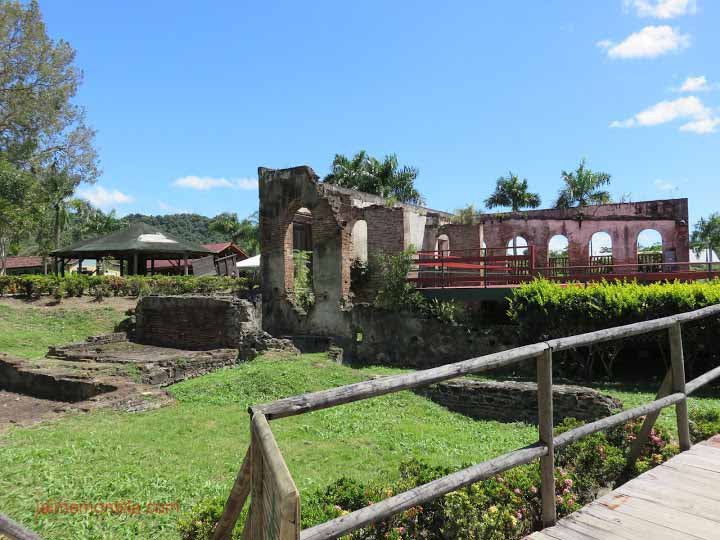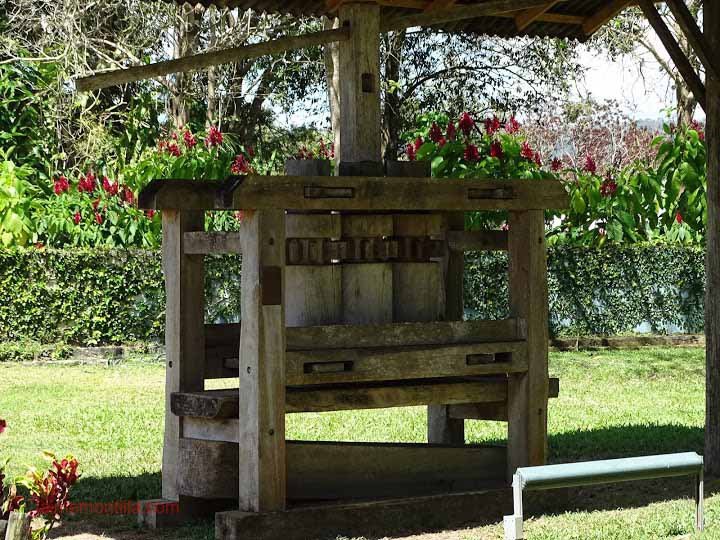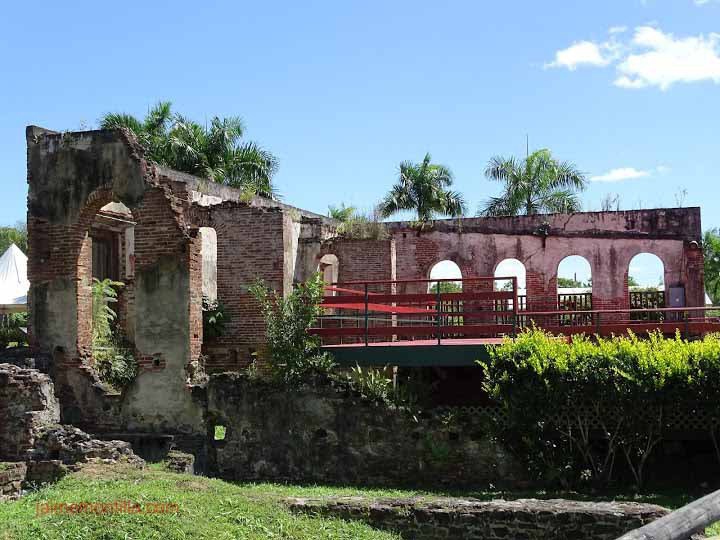
Hacienda San José
Hacienda San José was established ca. 1825 in Barrio Cañabón of Caguas by Spanish immigrant from Valencia José Ríos who by 1834 was one of the main taxpayers in the municipality of Caguas. The hacienda produced oranges, plantains, rice, bananas, coffee, and other crops but later on sugarcane became its principal product. After the death of José, his son Manuel Ríos Jimenez ( -1877) inherited the hacienda and introduced steam powered machinery and more efficient sugar production techniques.
Until 1863 when the area sugar production leadership passed on to Hacienda Santa Catalina, Hacienda San José was known as the major producer of sugar, rum and molasses in Caguas. After the US occupation in 1898, sugar production methods in Puerto Rico were modernized and a number of new central sugar factories were established. The trapiches could not compete and ended up being sugar cane suppliers or colonos of the big central sugar mills. Between 1900 and 1906, Hacienda San José processed little or no sugar due to family problems, according to the essay by José O. Solá Colonialism, Planters, Sugarcane, and The Agrarian Economy of Caguas, Puerto Rico, Between the 1890s and 1930 due to tragedies and legal matters related to inheritance. Solá also states that according to Luis Pumarada O'Neil, Hacienda San José continued processing its own sugarcane and producing muscovado sugar until 1910. The estalishment of Central Santa Juana in 1906 caused the majority of sugar growers in the area to stop manufacturing muscovado sugar and become only growers with colono agreements to procees their sugarcane at the new central sugar mill. Financial presure finaly obligated the owners of Hacienda San José to give in and become a colono of Central Santa Juana. Hacienda San José continued growing sugarcane until 1972 when it officially stopped its cultivating operations.
On April 30, 1920 a group of colonos of Central Santa Juana decided to establish their own central sugar mill they called Central Defensa. Its incorporators were Caguas Mayor at the time Juan Jimenez Garcia, Marcos Jimenez and José B. Mendez. The principal shareholders of Central Defensa were Fernando Guarch Ríos (1891-1956) the son of Spanish immigrant from Barcelona Antonio Guarch San Millán who had inherited Hacienda San José from his mother Lorenza Rios Colón the daughter of Manuel Ríos Jimenez, Pablo Héreter, Joaquín Vendrell, Cipriano Manrique, Manuel Quiñones Cabezudo, Domingo Lasa Quiñones, Nicolás Solá, Cándido Martinez, Martin Morris and Harrison Johnson.
The mill was constructed next to the old Hacienda Santa Catalina, with machinery from the then defunct Central Corsica in Rincón. Its first grinding season was 1923 when it produced 4,407 m. t. of sugar. Timing for the establishment of Central Defensa was ill conceived as the big sugar price crash of 1921 that ended the well known "dance of the Millions" put the new venture in financial trouble from its very beginning. In 1923 Central Defensa was sold to the Caguas Sugar Company, Inc. owned by Pura Blanco, Miles A. Martin and Moses A. Walker. In 1926, Central Defensa was one of the five sugar mills acquired by the United Porto Rican Sugar Co. In June 1939 Eastern Sugar Associates, the successor to the United Porto Rican Sugar Co. decided to close it down and move its mahinery to Central Santa Juana.
Today, fifty three cuerdas of what used to be Hacienda San José form part of the one hundred thirteen cuerdas Caguas Botanical Garden owned and maintained by the Caguas Municipal Government. Its remains have been very well kept as can be seen by the pictures below that show how technology changed at Hacienda San José; from a Spanish Train where kettles were heated individually to a Jamaican Train where kettles were heated in series by only one heat source, from animal driven wooden to animal driven steel covered crushers to a steam driven mill. In one of the pictures you can see the kettles in the order they were heated in the Jamaican Train with the larger one closest to the heat source and the smallest one the farthest away. Probably Hacienda San José has the best remaining structure then used as slave quarters or as it was called the of a "Barracón".
















